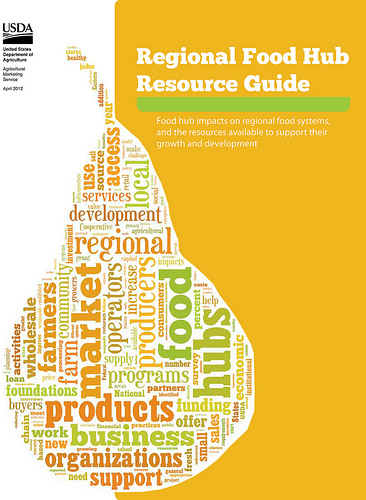Interest in more durable farm-to-market linkages along the food value chain continues to grow. A key component for making these market linkages is having accessible points of aggregation and distribution. Regional food hubs have developed in Virginia and across the country to serve this purpose. Food hubs are a critical food system link and an accessible point for producers, processors, and distributors to retail, wholesale, and institutional markets.

The Local Food Hub in Charlottesville, VA serves as a critical link for regional farmers and businesses in central Virginia.
The US Department of Agriculture defines a regional food hub as a business or organization that actively manages the aggregation, distribution, and marketing of source-identified food products primarily from local and regional producers to strengthen their ability to satisfy retail, wholesale, and institutional demand.
If you are interested in learning more about regional food hubs, below are some guides and informational reports in the form of an annotated bibliography to get you started.
Barham, James, Debra Tropp, Kathleen Enterline, Jeff Farbman, John Fisk, and Stacia Kiraly. Regional Food Hub Resource Guide. U.S. Dept. of Agriculture, Agricultural Marketing Service. Washington, DC. April 2012. Retrieved from https://www.ams.usda.gov/sites/default/files/media/Regional Food Hub Resource Guide.pdf
This guide from USDA Agricultural Marketing Service addresses frequently asked questions about food hubs such as 1) What is a regional food hub? 2) What kind of impacts are regional food hubs having in their communities? 3) What are some of the barriers impeding regional food hub growth and how might they be addressed? and 4) What financial resources are available to support regional food hub development?
Glasmeier, A. & Rogoff, J. (2014). Improving systems of distribution and logistics for regional food hubs. Cambridge, MA: Massachusetts Institute of Technology. Retrieved from https://dusp.mit.edu/project/improving-systems-distribution-and-logistics-regional-food-hubs
The Massachusetts Institute of Technology’s (MIT) Wealth Creation Clinic worked with the Central Appalachian Network (CAN) to study food system distribution and logistics of regional food hubs as a way to expand opportunities for small to mid-sized producers in the Central Appalachian region. The report consists of a literature review of distribution and logistics, case studies of regional food hub models, and recommendations for possible adoption and implementation.
National Association of Development Organizations Research Foundation. (2010). Regional Food Systems Infrastructure. Retrieved from https://www.nado.org/regional-food-systems-infrastructure/
The NADO Research Foundation published this report to outline the role of Regional Development Organizations (RDOs) can have in convening and supporting regional farmers, processors and distributors through the development regional food systems infrastructure as part of their economic development goals.
National Good Food Network. http://www.ngfn.org/
The National Good Food Network, coordinated and convened by the Wallace Center at Winrock International, brings together people from all parts of the food system including producers, buyers, distributors, advocates, educators, investors, and funders. The Network is a dedicated learning community devoted to scaling up good food sources and improving food access for all. The National Good Food Network maintains a database of food hub resources including reports, case studies, surveys, and webinars for creating better linkages and stronger values from the farm to the table.
United States Department of Agriculture. (2013). The role of food hubs in local food marketing. By Matson, J., Sullins, M., & Cook. C. USDA Rural Development Service Report 73. Retrieved from https://www.rd.usda.gov/files/sr73.pdf
Food hubs represent a strategy for producers, particularly small and mid-sized producers, to market their production locally and regionally. Food hubs can create new marketing opportunities for rural food producers. In this USDA Rural Development publication, the authors discuss the specific role food hubs can play to link producers to intermediated market channels to satisfy retail, wholesale, and institutional demand for local foods.
United States Department of Agriculture. (2016). Running a food hub: Assessing financial viability. Volume 3. By Matson, J., Thayer, J., & Shaw, J. USDA Rural Development Service Report 77. Retrieved from https://www.rd.usda.gov/files/publications/SR 77 FoodHubs Vol3.pdf
This circular is volume 3 of a technical report series from USDA Rural Development. The service report specifically looks at what is needed organizationally and financially to make a food hub viable.
United States Department of Agriculture. (2015). Running a food hub: A business operations guide. Volume 2. By Matson, J., Thayer, J., & Shaw, J. USDA Rural Development Service Report 77. Retrieved from https://www.rd.usda.gov/files/SR_77_Running_A_Food_Hub_Vol_2.pdf
This circular is volume two of a technical report series and provides guidance on how to start and run a food hub as a business operation.
United States Department of Agriculture. (2015). Running a food hub: Lessons from the field. Volume 1. By Matson, J., Thayer, J., & Shaw, J. USDA Rural Development Service Report 77. Retrieved from https://www.rd.usda.gov/files/SR_77_Running_A_Food_Hub_Vol_1.pdf
This USDA circular report outlines the current research on the operation of 11 food hubs and provides lessons learned these business operations.

